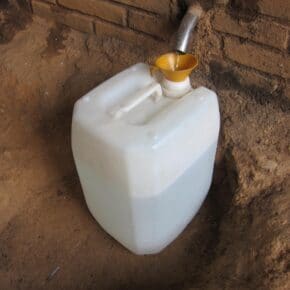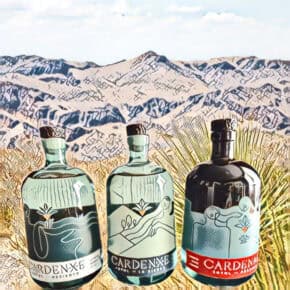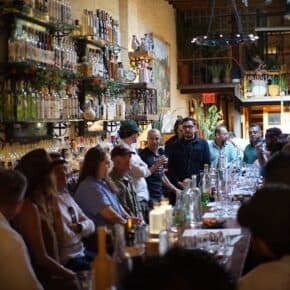Casa Lumbre Spirits has been on a bit of a tear this year. The company has released three new products in the US. The first was a line of gin called Las Californias, which matched botanicals from the two sides of California, the US and Mexico. That fit into a market slot that we’ve been seeing a lot of lately. Most generally, gins with different botanicals. More specifically, Mexican gins.
But the the latest two releases have created a fair amount of controversy because of who and how the company interprets traditional categories. First, it released Contraluz, a cristalino Mezcal in partnership with Colombian Reggaeton star Maluma. Now, it adds a sotol, the ambitious Nocheluna which is a partnership of several players– Casa Lumbre Spirits, Pernod Ricard, Ricardo Pico, Sotolero Don Alfredo Garza, Sotolero Don Eduardo “Lalo” Arrieta, and Lenny Kravitz.
Sotol is both a spirit and the local name for the Dasyliron plant used to make it. The spirit sotol is often lumped together with agave spirits because the production process is so similar and, occasionally, because the two are mixed together when making spirits. There is also some debate on how closely related the Dasylirion plant is to agave. Both are part of the Asparagaceae family. Both reproduce through flowering stalks. Both develop piñas that are harvested, roasted, crushed, fermented, distilled into a drinkable spirit and sold into a market. But, until now, Sotol has remained a tiny niche in the tiny niche of non-tequila Mexican craft spirits. The scope and celebrity power behind Nocheluna could change that.
The beginning of the project
The idea for Nocheluna began about five years ago, when Casa Lumbre’s CIO Dr. Ivan Saldaña visited Chihuahua with Ricardo Pico as his guide. At the time Saldaña was the lead of Montelobos and the Ancho Verde and Reyes projects. Pico was making a name for himself through his work with several small sotoleros and which became the Clande Sotol brand. Saldaña was so impressed with what he saw and tasted, that the idea of a collaboration between Montelobos and Clande was born. Eventually, it became its own project.
The first vinata was built on Don Alfredo Garza’s ranch, La Vinata, about 4.5 hours from the city of Chihuahua. Don Alfredo’s great grandfather had a clandestine vinata on the ranch during the years when making sotol was illegal. Don Lalo also produced his sotol in this vinata. Eventually, they decided to move the vinata to Aldama which is much closer to Chihuahua. The new vinata, where all production is overseen by Don Lalo, now has 25 employees, which according to Pico “pays very fair wages, well above anything before this partnership.”
Don Lalo is a 4th generation sotolero: At 69 years old, he has been making sotol for most of his life. For Pico, bringing Don Lalo into the partnership to oversee all production was a no brainer given his breadth of experience and his delicious sotol. Don Lalo’s involvement in Nocheluna is very emotional for Pico, who views him as a father figure, especially in the wake of his father’s passing five years ago. “This was like a second chance for me. When my father lived, I was not in the financial position to take him out and have a nice dinner, or be able to take him on a trip. With Don Lalo, I had the opportunity to help create a project that would enable Don Lalo and his family to be financially set for life. This was incredibly important to me.” Also important to Pico, how the project supports his work with other small producers and his current Sotoleros project.
From wild harvest to a future of cultivated Dasylirion
Nocheluna is currently made from wild harvest Dasylirion Leiophyllum. The bulk of the plants come from Rancho la Vinata which owned by Don Alfredo and his family. Additional plants come from other private ranch land in Chihuahua and, occasionally, from rancher cooperatives in the area. Federal laws in Mexico and local permitting in Chihuahua require that only 30% of the plants growing in the wild be harvested. This maintains natural populations and keeps regrowth rates viable.
Plans are in place to scale the project with increased demand, including cultivating the Dasylirion plant on almost 100 hectares (about 240 acres). According to Pico, this is the first time cultivation has happened at this scale and outside of research at the University of Chihuahua. Casa Lumbre is working with Dr. Jesus Miguel Olivas, a professor at the University of Chihuahua who specializes in research in Forestry, Agronomy and Environmental Science. His research into the cultivation of Dasylirion has shown that, in protected environments, the plant will mature earlier than the usual 10-12 years it can take. Additionally, there is a higher brix, or sugar content, in cultivated Dasylirion. The company is anticipating that the initial plantings will be ready for harvest in 5-6 years. They are also germinating from seed to ensure a steady diversity and source of Dasylirion into the future as well testing out two different farming techniques, a fully cultivated method as well as a semi cultivated method which leaves everything intact.
Like so many other regions in the west and southwest, water is a critical issue. The impact of climate change has only made this issue more pressing. Pico sees the potential for cultivating Sotol as a true game changer. “Right now in Chihuahua there are a lot of pecan orchards and these are very water intensive. Chihuahua is a desert climate and water resources are scarce. Cultivating sotol makes sense, it is a plant of the desert and requires very little water. This can be a crop for the future of the state creating all sorts of opportunities for the people here.”
The celebrity factor
But one of – if not the – factor that distinguishes what Casa Lumbre is doing in the Mexican spirits space is their embrace of the celebrity endorser. This isn’t anything new in agave spirits in general where The Rock has one of the best selling tequilas nor mezcal in particular where the co-stars of Breaking Bad are behind Dos Hombres mezcal. But Casa Lumbre has clearly made this their model and has now partnered with three different celebrities on three different projects: First with Mexican actor Luis Gerardo on Ojo de Tigre, then with Maluma on Contraluz, and now with Lenny Kravitz.
The celebrity endorsement is designed to reach and sell audiences on something that they wouldn’t have otherwise heard about or tried. Additionally most consumers simply don’t take the time to learn much about what they’re buying. For them, celebrities and influencers bridge the gap of knowledge. It’s been an enormously successful model everywhere else so it was only a matter of time before someone applied it to mezcal and other Mexican craft spirits. But Casa Lumbre appears to be making it into a real formula.
And that is the issue for many agave spirits aficionados. They’re focused on loving a spirit because of what they know about it. When it suddenly gets branded with a celebrity’s face and consumers buy it just because of that connection, the bond with the culture behind it can be threatened. But there’s a corollary here to consider: What if a company like Casa Lumbre is using that celebrity endorsement formula to make mass market spirits in a more sustainable fashion? And, what if they’re doing it in a way that opens the door to everyone else in the category? There are critical arguments on all sides of this but it’s definitely time that we had the wider discussion.












Noticed a bottle on the shelf yesterday. It’s labeled Dasy. spp. not leiophyllum.
Hmmm, interesting – will reconfirm with them as they told me Leiophyllum.